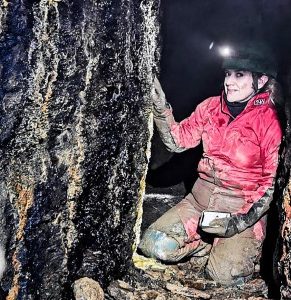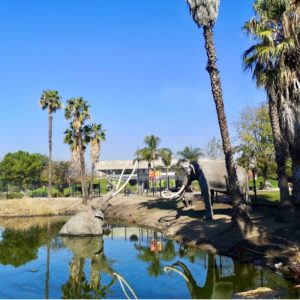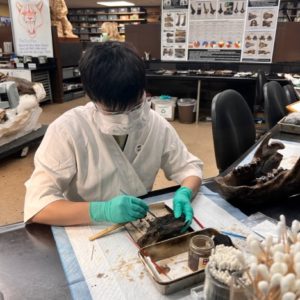Is bitumen in Whitby jet? Let’s talk about tar.
Whitby jet is partially formed from bitumen. Without it there would be no Whitby Jet, but why? It is possible to study bitumen at La Brea Tar Pits, Los Angeles to gain insight into jet formation.
The definition of jet is a
drifted wood, with a secondary impregnation of bitumen from its surrounding sedimentary environment’ (Stach, Murchison et al. 1982).”
This may seem a little fanciful at first glance but on consideration perhaps not. Jet does after all seem to share many physical properties with solidified bitumen, or asphalt as it is commonly referred to in the U.S.

Where does bitumen come from?
Thinking about road surfacing, the situation in which most modern humans encounter a material like asphalt or bitumen in a liquid form (although this road surfacing material is usually artificially created). It is indeed jet-black, has a glossy lustre and smells rather lovely, just like the aroma we sometimes smell when cutting jet. When it cools it sets hard and looks remarkably jet-like.

Bitumen in the Whitby rocks.
In the case of Whitby jet the bitumen with which it is impregnated is derived from the Mulgrave Shales, the ‘Jet Rock’ as it used to be called. This bitumen occurs in these rocks by the same processes that generated the hydrocarbons that give us North Sea Oil.
What is bitumen?
In fact bitumen is actually a sticky, black, highly viscous liquid or semi-solid form of petroleum. In the Whitby stratigraphy we don’t often see much evidence of this oil or bitumen at the surface. We need to venture underground into the abandoned Victorian jet mines to see the bitumen which occurs as sticky black coverings on the walls of the mine tunnels and adits.

Bitumen production today: The La Brea Tar Pits
There are places on earth today however where we can study the effects of bitumen both in the fossil record, and observe it being generated in real time.

Can tar make fossils?
The La Brea Tar Pits in Los Angeles have fascinated scientists and visitors for over a century. Today, this area is the only actively excavated Ice Age fossil site found in an urban location in the world. Over the last 50,000 years, a diverse range of animals, plants, and insects were trapped in sticky bitumen, which preserved them in amazing detail. They range in size from huge mammoths and sloths to ‘microfossils’, the tiny remains of plants and animals that give us clues about how ancient ecosystems and climates changed.
Is tar bitumen?
The name La Brea is the Spanish term for pitch or tar, however the black gooey substance bubbling to the surface is actually bitumen. A large petroleum reservoir called the Salt Lake Oil Field is located below the surface at La Brea. The oil was formed from marine plankton deposited in an ocean basin during the Miocene Epoch (5-25 million years ago). The petroleum has been gradually migrating to the surface, either along a fault zones or along steeply dipping, porous sedimentary rock layers.

La Brea means ‘tar’ in Spanish
The iconic Lake Pit, located in front of the La Brea Museum, is a remnant from asphalt mining operations in the late 1800s. Rain and groundwater has collected above the bubbling asphalt, creating a small lake. Methane also bubbles to the surface giving a distinctive sulphurous odour, with the addition of a family of mammoths soon to become trapped in the “tar”.

During the last 50,000 years, the La Brea tar pits have trapped and preserved animals and plants that lived in the surrounding area.
Research at La Brea Tar Pits: Can tar make fossils?
The museum housed within the Hancock Park is dedicated to these finds of the tar pits. The researchers there have recovered more than one million bones since 1906, representing over 231 species of vertebrates. In addition, 159 species of plants and 234 species of invertebrates have been identified. However, it is estimated that the collections at La Brea Tar Pits contain about three million items. Although tar can make fossils it also makes them rather difficult to study. Once removed the artefacts are brought into the museum labs where they are cleaned and catalogued prior to further research.

Many of the finds are then recreated within the museum galleries such as this magnificent Columbian mammoth photographed below.

Bitumen in the archaeological record
The museum also houses a number of artefacts which document Native American usage of bitumen in the local area. To someone such as myself who researches human interaction with hydrocarbons over the millennia these objects are fascinating. The natural bitumen was exploited for its waterproofing properties by smearing it on woven baskets.
Bitumen used for waterproofing baskets

Bitumen used as an adhesive
The bitumen was also used as an adhesive to attach flints to arrow shafts and hooks to fishing lines and poles. It was also used for decorative applications, such as this steatite vessel (fig.10 below) decorated with olivella beads inlaid into the bitumen to secure them.

Bitumen used to secure quartz scrapers
Quartz crystal points have also been discovered embedded in bitumen. It is likely used to hold them in place so that they could be used for scoring softer materials such as jet, shell and turquoise in jewellery making.

In summary: Whitby jet needs bitumen
Whereas at La Brea, the bitumen was certainly responsible for the demise of many creatures and aided their remarkable preservation. The process is however very different to that observed in the formation of jet. Jet is formed by jetonisation, a process which is poorly understood at present. Jetonisation in the Whitby area is however impossible without bitumen as an agent. The story is however more complicated than one of simple impregnation. I will cover jetonisation in future blogs. In the meantime check out https://tarpits.org for the latest research on the Ice Age fossils of La Brea.
References
Stach, E., et al. (1982). Stach’s textbook of coal petrology, Borntraeger Berlin.

